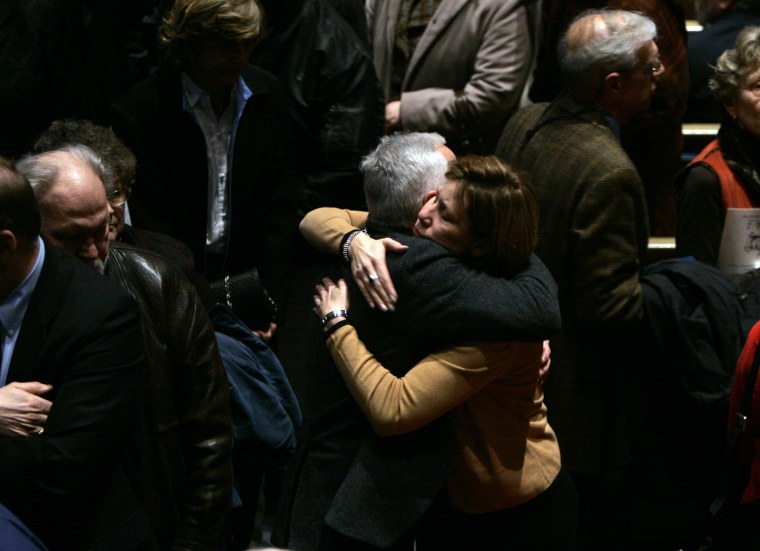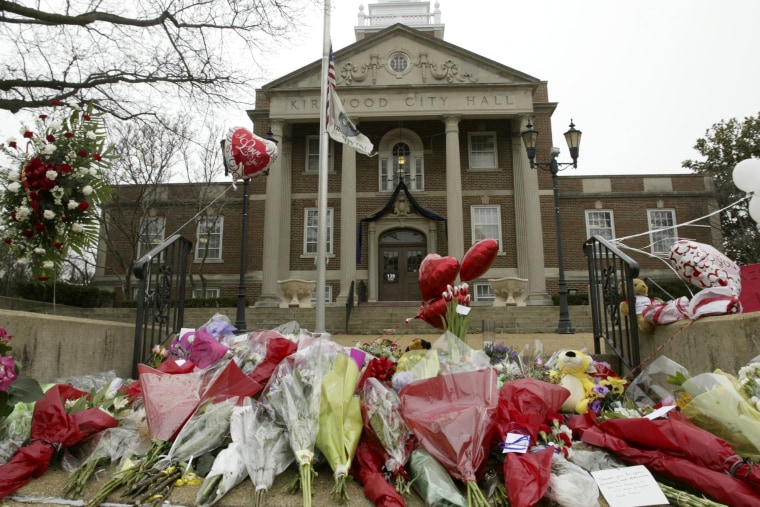KIRKWOOD, Missouri — Jean Loemker had planned to attend a city council meeting here one Thursday evening in February 2008, but she was tired and fell asleep on the couch with her TV on. When she woke later, a breaking news alert flashed on screen saying there had been a mass shooting at city hall.
“My first thought was: Cookie has lost it. I knew right then it was Cookie,” she recalled six years later, sitting in a coffeeshop directly across the street from where Charles Lee "Cookie" Thornton killed five people and injured two others in the council chambers before being killed by police.
Thornton was black and the city leaders were mostly white. The shooting exposed racial tension in this affluent St. Louis suburb about 20 miles south of Ferguson, which has been rocked by two weeks of its own racial unrest after a white police officer killed Michael Brown, an unarmed black teenager.
Now, as Ferguson begins to look for a path forward, the city might find lessons in Kirkwood, which has found some success in bridging its own racial divide after a violent flash point that is still never far from residents’ minds.
The memory of the shooting, which attracted national attention, was revived for some Ferguson residents this week as the city prepared to hold its first council meeting since Brown's death. Officials ultimately decided to cancel the meeting, citing security concerns.
"It was just one person acting, it had nothing to do with the rest of our community."'
Thornton’s grievances with the white establishment of Kirkwood were personal and bureaucratic — “It was just one person acting, it had nothing to do with the rest of our community,” Mayor Art McDonnelll told msnbc — but they were the offspring of a forced marriage between two very different communities years earlier, as documented in a four-part St. Louis Magazine series and various other media reports.
In 1991, the mostly white Kirkwood annexed Meacham Park, a historic but run-down black neighborhood in unincorporated St. Louis County where Thornton lived. The merger was approved by large margins in both communities, but problems soon arose.
Not long after the merger, Kirkwood invoked eminent domain to take over large swaths of Meacham Park —much of it blighted or home to Section 8 housing — in order to build a Wal-Mart Supercenter and other commercial developments.
Eventually two-thirds of the neighborhood would be taken and Meacham Park’s population would fall by 30%. The community's mostly black, mostly poor residents numbered less than 800, and they were swept into a city of more than 27,000, only 7% of whom were black.
The character of Meacham Park, whose streets are named after black luminaries like Crispus Attucks and which traces its roots back to 1896, seemed imperiled.
Even now, some residents feel they were cheated out of their land, says Harriet Patton, a longtime African-American activist in the neighborhood who heads the Meacham Park Neighborhood Improvement Association. “There are still some people who share that disposition and have not been very pleased with city officials and getting some resolution with their individual land,” she told msnbc.
Kirkwood has promoted its efforts to integrate the communities, including investing millions of dollars in infrastructure and home improvements. They built a handsome park in the center of the neighborhood. But everyone, white and black, agrees there’s still more to be done.
In its 2013 Annual Report, the city’s official Human Rights Commission wrote that it “continued to monitor the relationship between the City of Kirkwood and the Meacham Park neighborhood. The issues are long standing and deep, they need attention.” It took until last year for a subdivision of Kirkwood to remove unenforceable language from its bylaws prohibiting African-Americans from owning homes in the area.

For Thornton, a black resident of Meacham Park, the problems were more idiosyncratic. Suddenly, things he had done for years, like park his business’ trucks on residential property, were illegal under Kirkwood’s city ordinances. As violations piled up, he fought a one-man war with city hall and lost at almost every turn. The defeats only seemed to further confirm his suspicions of a racist conspiracy against him, and drove him to more dramatic and unhinged displays of defiance, especially at Kirkwood City Council meetings, according to residents.
Loemker, a social worker who is now the area’s Democratic National Committeewoman, went to at least a year's worth of meetings with Thornton while she was pushing the city to adopt an anti-smoking ordinance.
He was eccentric and pushed the envelope too far, she said, recalling a time he got dragged out of a meeting in handcuffs. But he was also funny and well-known in his community, where he was involved in charitable causes. “Cookie wanted a voice, he wanted to be heard. And he never felt like he was being heard,” she said.
Thornton grew increasingly erratic, getting into a physical confrontation with a city official at a local bar and picketing outside the mayor’s house. Not long after a federal court dealt him a final legal blow, Thornton went to city hall. This time he was armed.
Just as the city council meeting was about to begin on Feb. 7, 2008 , he started his rampage by shooting a police officer outside city hall. Thornton then took the officer’s gun, entered the council chamber, and shot the mayor, two council members, the public works director, a reporter, and another police officer. He died there behind a desk under a hail of police gunfire. The mayor later succumbed to his injuries.
Six years later, Kirkwood and Meacham Park have tried to find positive lessons from the tragedy. They held months of meetings to build relationships between the two sides of town, brought in a consultant who helps municipalities with tensions like these, worked to build trust between police and black residents, strengthened the human rights commission, and took other steps.
The measures helped, black and white leaders agree, but the effort is still a work in progress. “We are a closer-knit community and one that is proud of itself for what we have accomplished,” said Mayor McDonnell, who, like most city leaders, is white.
"I’m proud of Kirkwood. I think we’ve moved in a positive direction."'
Jeffrey Blair, an African-American resident of Meacham Park who sits on the Neighborhood Improvement Association board agreed. “I'm proud of Kirkwood. I think we've moved in a positive direction,” he said.
Already, the community is looking for ways to help Ferguson. Blair said that while the two violent incidents are “extremes,” they are emblematic of racial problem prevalent throughout St. Louis and so many other American cities. “Something horrific happens, and without that happening, people don't realize that there are these inequities,” he explained.
In some ways, what happened in Kirkwood and Ferguson are almost the inverse of each other. In Ferguson, the act of one man provoked a community to revolt; in Kirkwood, the experience of a minority community helped provoke the action of one man.
“Cookie had anguish built up in him for the neighborhood,” his friend Chuck Reynolds Jr. told The New York Times shortly after the shooting.
Blair said leaders are already looking for ways to help Ferguson. There are plans for meetings with faith leaders in the two communities, some of which have already taken place, an event at a local church to show solidarity, and talk of political leaders joining together. Loemker invited Ferguson’s Democratic National Committeewoman, Patricia Bynes, to attend the party’s next meeting.
The key, both white and black residents agreed, is to build personal relationships across the divide, which is easier said than done.
Patton, who has often sparred with city officials, said a key pitfall to avoid is “uncontrolled anger.”
“The message that seems so needed is that there's no winner in the fighting amongst the races. The blacks don't win, the whites don't win. So we might as well recognize that we're on this earth together,” she said.
This year, Cookie’s nephew Jayson Thornton ran for city council. The treasurer for the neighborhood association, the younger Thornton is respected in Meacham Park. He fell short of winning the seat, but garnered 1,300 votes, which Patton said is a good sign.
For Todd Smith, the positive change he sought was more personal. Smith was the reporter who was shot while covering the meeting for the local Suburban Journals, and he could not have expected the routine assignment would change his life. Smith told msnbc he probably could never feel comfortable at an event like that again.
Today he works for Fathers' Support Center, a St. Louis organization that works to help African-American fathers get involved in the lives of their children. The group has helped more than 11,000 fathers and over 26,000 children in the area, and just graduated a new class from the program this month. The group's youth director attended Michael Brown’s funeral.
“I don't know if I would be doing what I am doing now if I didn't have that horrible experience happen,” he recalled. “If you're faced with this situation, you can either turn very negative or make a positive as best you can out of it.”
